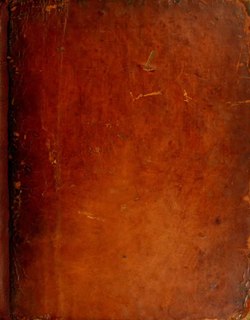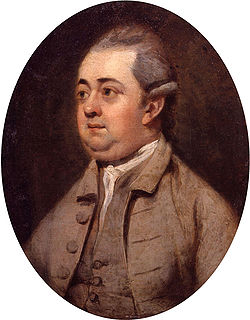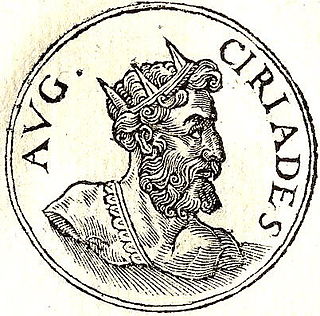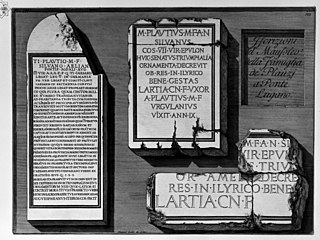Related Research Articles

Aelianus Tacticus, also known as Aelian, was a Greek military writer who lived in Rome.

Edward Gibbon was an English historian, writer, and Member of Parliament. His most important work, The History of the Decline and Fall of the Roman Empire, published in six volumes between 1776 and 1788, is known for the quality and irony of its prose, its use of primary sources, and its polemical criticism of organised religion.

The History of the Decline and Fall of the Roman Empire is a six-volume work by the English historian Edward Gibbon. It traces Western civilization from the height of the Roman Empire to the fall of Byzantium in the fifteenth century. Volume I was published in 1776 and went through six printings. Volumes II and III were published in 1781; volumes IV, V, and VI in 1788–1789.
The Minyades were three Orchomenian (Arcadian) princesses in Greek mythology. These sisters were protagonists of a myth about the perils of neglecting the worship of Dionysus.

Sir William Smith was an English lexicographer. He became known for his advances in the teaching of Greek and Latin in schools.

The six-volume work The History of the Decline and Fall of the Roman Empire by the English historian Edward Gibbon (1737–1794) has been reprinted many times over the years in various editions.

Cyriades was a Roman rebel who betrayed the city of Antioch to Shapur I sometime during the 250s. His chief claim to fame is that he is enumerated as one of the Thirty Tyrants who supposedly tried to overthrow the emperor Gallienus.

The Dictionary of Greek and Roman Biography and Mythology is an encyclopedia/biographical dictionary. Edited by William Smith, the dictionary spans three volumes and 3,700 pages. It is a classic work of 19th-century lexicography. The work is a companion to Smith's Dictionary of Greek and Roman Antiquities and Dictionary of Greek and Roman Geography.
Rhytium or Rhytion, also called Rhytiassus or Rhytiassos, was a town of ancient Crete which Homer couples with Phaestus in the Catalogue of Ships in the Iliad as "well-peopled cities." The city belonged to the Gortynians. Earlier it was thought that the reading Rhythimne (Ῥυθίμνη) in the entry of Stephanus of Byzantium on Stelae should be emended into Rhytium (Ῥύτιον), but today it seems that Rhithymna or Rhittenia was meant. The city continued to be independent until the Hellenistic period. According to Strabo, it then came under the rule of Gortyn and declined. Rhytion remained inhabited, although insignificant, until the Byzantine period, until, according to Claudius Aelianus, the citizens were forced to leave by an insect plague.
The Gildonic War was a rebellion in the year 398 led by Comes Gildo against Roman emperor Honorius. The revolt was subdued by Stilicho, the magister militum of the Western Roman empire.
Aelianus Meccius was an ancient physician, who must have lived in the 2nd century AD, as he is mentioned by Galen as the oldest of his tutors. His father is supposed to have also been a physician, as Aelianus is said by Galen to have made an epitome of his father's anatomical writings. Galen speaks of that part of his work which treated of the Dissection of the Muscles as being held in some repute in his time, and he always mentions his tutor with respect. During the prevalence of an epidemic in Italy, Aelianus is said by Galen to have used the Theriaca with great success, both as a means of cure and also as a preservative against the disease. He must have been a person of some celebrity, as this same anecdote is mentioned by the Arabic historian Abu al-Faraj, with exactly the same circumstances except that he makes the epidemic to have broken out at Antioch instead of in Italy. None of his works are now extant.

Tiberius Plautius Silvanus Aelianus was a Roman patrician who twice served as consul, in 45 and 74 AD. He was the adopted nephew of Plautia Urgulanilla, first wife of the emperor Claudius. It is known he offered up the prayer as pontifex when the first stone of the new Capitol was laid in 70 AD. In some ancient sources he is referred to as Plautius Aelianus, but we learn from an inscription that his full name was Tiberius Plautius Silvanus Aelianus, and that he held many important military commands.
Sortes were a frequent method of divination among the ancient Romans. The method involved the drawing of lots (sortes) to obtain knowledge of future events: in many of the ancient Italian temples the will of the gods was consulted in this way, as at Praeneste and Caere.
Cleinias of Tarentum was a Pythagorean philosopher, and a contemporary and friend of Plato, as appears from the story which Diogenes Laërtius gives on the authority of Aristoxenus, to the effect that Plato wished to burn all the writings of Democritus which he could collect, but was prevented by Cleinias and Amyclus of Heraclea. In his practice, Cleinias was a true Pythagorean. Thus, we hear that he used to assuage his anger by playing on his harp; and, when Prorus of Cyrene had lost all his fortune through a political revolution, Cleinias, who knew nothing of him except that he was a Pythagorean, took on himself the risk of a voyage to Cyrene, and supplied him with money to the full extent of his loss.
The gens Anicia was a plebeian family at ancient Rome, mentioned first towards the end of the fourth century BC. The first of the Anicii to achieve prominence under the Republic was Lucius Anicius Gallus, who conducted the war against the Illyrii during the Third Macedonian War, in 168 BC.
Antenor was a Greek writer of uncertain date, wrote a work upon the history of Crete, which on account of its excellence was called Delta (Δέλτα), inasmuch as, says Ptolemy Hephaestion, the Cretans called that which is good Delton (Δέλτον).
Gryllus was the elder son of Xenophon. When the war, which broke out between Elis and Arcadia in 365 BC, on the subject of the Triphylian towns, had rendered a residence at Scillus no longer safe, Gryllus and his brother Diodorus were sent by Xenophon to Lepreum for security. Here he himself soon after joined them, and went with them to Corinth.
Aristomache was the daughter of Hipparinus of Syracuse, and the sister of the Sicilian tyrant Dion of Syracuse.
Thenae or Thenai was a town of ancient Crete close on the Omphalian Plain, and near Cnossus. William Smith, writing in the 19th century, says it must have been close to the Temenos Fortress which was built in 961, when the Emirate of Crete was vanquished by Nicephorus Phocas and the forces of the Byzantine Emperor. However, modern scholars treat its site as unlocated.
Scylla or Scyllae was a town of ancient Thrace, on the Euxine, where the long wall, erected by the emperor Anastasius I Dicorus for the defence of Constantinople, terminated. This wall commenced at Selymbria, on the Propontis, and was carried across the narrow part of Thrace, at the distance of about 40 miles (64 km) from Constantinople, its length being 2 days' journey.
References
- ↑ Eutrop., ix. 13
- ↑ Aurel. Vict., de Caes 89
- ↑ Smith, William (1867), "Aelianus", in Smith, William (ed.), Dictionary of Greek and Roman Biography and Mythology , 1, Boston, p. 28, archived from the original on 2011-06-05, retrieved 2007-10-20
- ↑ Gibbon, Edward. A History of the Decline and Fall of the Roman Empire. Christian Classics Ethereal Library. https://www.ccel.org/g/gibbon/decline/volume1/chap13.htm.<Accessed Oct 5, 2021>
 This article incorporates text from a publication now in the public domain : Smith, William, ed. (1870). "Aelianus". Dictionary of Greek and Roman Biography and Mythology .
This article incorporates text from a publication now in the public domain : Smith, William, ed. (1870). "Aelianus". Dictionary of Greek and Roman Biography and Mythology .